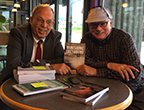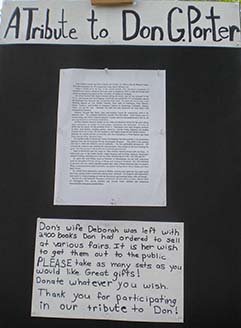John Steinbeck, one of the 20th century’s literary giants, was known for his raw, emotionally powerful novels. Yet behind his iconic works like The Grapes of Wrath and Of Mice and Men, there was an unexpected ritual—one that may surprise even the most ardent Steinbeck fans. Before he penned a single word, Steinbeck would sit down and sharpen a dozen or more pencils, preparing each as if it was the key to his creativity.
For Steinbeck, sharpening pencils was more than just a practical task to ensure he had writing tools on hand. As simple as it seems, this process was a crucial part of his mental preparation. Each pencil he sharpened became a step toward clearing his mind and focusing his thoughts, a way to transition from the clutter of daily life to the clarity he needed to craft his stories.
He preferred Blackwing 602 pencils, known for their dark, smooth lead and their famous slogan: “Half the Pressure, Twice the Speed.” Blackwing 602s are considered one of the finest pencils by artists and writers alike, and Steinbeck’s choice reflects his appreciation for quality. These pencils became a staple that he often sharpened up to two dozen each morning. Each pencil was lined up neatly on his desk, ready to be used until its point dulled, and it was time to pick up the next. This lineup of sharpened pencils was more than just preparation; it was a kind of ritual, a process that symbolized his readiness to begin the work of writing.
Interestingly, Steinbeck’s relationship with his pencils went beyond mere utility. He saw each pencil as a companion in his creative journey, a small yet indispensable part of writing. The repetitive nature of sharpening them, the sound of the pencil sharpener, and the tactile feel of freshly sharpened wood became his way of mentally gearing up for the day’s work. It was a meditative ritual that calmed his mind and allowed him to focus on his thoughts and ideas.
Steinbeck’s pencil-sharpening ritual also speaks to the power of routine in creative work. For many writers and artists, transitioning from ordinary life to creative flow can be challenging. Routines, especially tactile ones like sharpening pencils, bridge the two worlds. In Steinbeck’s case, this ritualistic preparation was more than just having ready tools. It was a small but mighty way to mentally prepare himself and summon focus and discipline before diving into the demanding storytelling process.
Why was sharpening pencils so essential for Steinbeck? The answer may lie in the act’s repetitive nature. Repetition is known to have a calming effect on the mind, a kind of mental reset that can clear away distractions and help a person focus. Steinbeck’s ritual wasn’t unique in creative minds—many artists and writers have similar practices that help them transition into a creative mindset. But it’s easy to imagine Steinbeck quietly sitting at his desk each morning, sharpening each pencil with care, almost like a monk preparing for meditation. For him, this moment of quiet, this routine of preparing his tools, was a way of grounding himself before he took on the emotional and intellectual work of writing.
Once his pencils were lined up and ready, Steinbeck could start writing, knowing that he had prepared his environment to suit his needs. And as each pencil’s tip wore down, he’d set it aside and reach for the next, a visual marker of his progress. By the time all the pencils were used, he had often spent hours working, pouring his thoughts and emotions onto the page. It was as if each pencil carried a piece of the story, a tool transforming ideas into words that would echo across generations.
Steinbeck’s reliance on this ritual reminds us that the simplest actions can sometimes have profound effects. A grounding ritual like Steinbeck’s can become a powerful tool in the writing world, where inspiration can feel elusive and distractions are endless. It didn’t matter that his ritual involved a task as mundane as sharpening pencils; what mattered was the sense of calm, the mental clarity, and the readiness it instilled. For Steinbeck, this small act became an essential part of his creative process, a unique blend of practicality and superstition that helped him craft stories with depth and empathy.
Today, writers may not all reach for a pencil sharpener before they begin, but Steinbeck’s ritual serves as a reminder of the power of routine. In a chaotic and noisy world, perhaps we could all benefit from a moment of stillness, a simple action that brings focus and intention to our work. So, consider taking a page from Steinbeck’s book next time you sit down to write. Whether sharpening a pencil, brewing a cup of coffee, or clearing your desk, find a small ritual that helps you transition into the creative space. After all, if Steinbeck could unlock his creativity with a dozen sharpened pencils, who’s to say what small habit might unlock yours?
We Don’t Want to Write the Laws; We Want to Publish the Books
Publication Consultants: The Synonym for Book Publishing—https://publicationconsultants.com




 This is Publication Consultants’ motivation for constantly striving to assist authors sell and market their books. Author Campaign Method (ACM) of sales and marketing is Publication Consultants’ plan to accomplish this so that our authors’ books have a reasonable opportunity for success. We know the difference between motion and direction. ACM is direction! ACM is the process for authorpreneurs who are serious about bringing their books to market. ACM is a boon for them.
This is Publication Consultants’ motivation for constantly striving to assist authors sell and market their books. Author Campaign Method (ACM) of sales and marketing is Publication Consultants’ plan to accomplish this so that our authors’ books have a reasonable opportunity for success. We know the difference between motion and direction. ACM is direction! ACM is the process for authorpreneurs who are serious about bringing their books to market. ACM is a boon for them. Release Party
Release Party Web Presence
Web Presence Book Signings
Book Signings Facebook Profile and Facebook Page
Facebook Profile and Facebook Page Active Social Media Participation
Active Social Media Participation Ebook Cards
Ebook Cards The Great Alaska Book Fair: October 8, 2016
The Great Alaska Book Fair: October 8, 2016


 Costco Book Signings
Costco Book Signings eBook Cards
eBook Cards

 Benjamin Franklin Award
Benjamin Franklin Award Jim Misko Book Signing at Barnes and Noble
Jim Misko Book Signing at Barnes and Noble
 Cortex is for serious authors and will probably not be of interest to hobbyists. We recorded our Cortex training and information meeting. If you’re a serious author, and did not attend the meeting, and would like to review the training information, kindly let us know. Authors are required to have a Facebook author page to use Cortex.
Cortex is for serious authors and will probably not be of interest to hobbyists. We recorded our Cortex training and information meeting. If you’re a serious author, and did not attend the meeting, and would like to review the training information, kindly let us know. Authors are required to have a Facebook author page to use Cortex. Correction:
Correction: This is Publication Consultants’ motivation for constantly striving to assist authors sell and market their books. ACM is Publication Consultants’ plan to accomplish this so that our authors’ books have a reasonable opportunity for success. We know the difference between motion and direction. ACM is direction! ACM is the process for authors who are serious about bringing their books to market. ACM is a boon for serious authors, but a burden for hobbyist. We don’t recommend ACM for hobbyists.
This is Publication Consultants’ motivation for constantly striving to assist authors sell and market their books. ACM is Publication Consultants’ plan to accomplish this so that our authors’ books have a reasonable opportunity for success. We know the difference between motion and direction. ACM is direction! ACM is the process for authors who are serious about bringing their books to market. ACM is a boon for serious authors, but a burden for hobbyist. We don’t recommend ACM for hobbyists.

 We’re the only publisher we know of that provides authors with book signing opportunities. Book signing are appropriate for hobbyist and essential for serious authors. To schedule a book signing kindly go to our website, <
We’re the only publisher we know of that provides authors with book signing opportunities. Book signing are appropriate for hobbyist and essential for serious authors. To schedule a book signing kindly go to our website, < We hear authors complain about all the personal stuff on Facebook. Most of these complaints are because the author doesn’t understand the difference difference between a Facebook profile and a Facebook page. Simply put, a profile is for personal things for friends and family; a page is for business. If your book is just a hobby, then it’s fine to have only a Facebook profile and make your posts for friends and family; however, if you’re serious about your writing, and it’s a business with you, or you want it to be business, then you need a Facebook page as an author. It’s simple to tell if it’s a page or a profile. A profile shows how many friends and a page shows how many likes. Here’s a link <> to a straight forward description on how to set up your author Facebook page.
We hear authors complain about all the personal stuff on Facebook. Most of these complaints are because the author doesn’t understand the difference difference between a Facebook profile and a Facebook page. Simply put, a profile is for personal things for friends and family; a page is for business. If your book is just a hobby, then it’s fine to have only a Facebook profile and make your posts for friends and family; however, if you’re serious about your writing, and it’s a business with you, or you want it to be business, then you need a Facebook page as an author. It’s simple to tell if it’s a page or a profile. A profile shows how many friends and a page shows how many likes. Here’s a link <> to a straight forward description on how to set up your author Facebook page.



 Mosquito Books has a new location in the Anchorage international airport and is available for signings with 21 days notice. Jim Misko had a signing there yesterday. His signing report included these words, “Had the best day ever at the airport . . ..”
Mosquito Books has a new location in the Anchorage international airport and is available for signings with 21 days notice. Jim Misko had a signing there yesterday. His signing report included these words, “Had the best day ever at the airport . . ..”



 The Lyin Kings: The Wannabe World Leaders
The Lyin Kings: The Wannabe World Leaders
 Time and Tide
Time and Tide


 ReadAlaska 2014
ReadAlaska 2014 Readerlink and Book Signings
Readerlink and Book Signings
 2014 Independent Publisher Book Awards Results
2014 Independent Publisher Book Awards Results

 Bonnye Matthews Radio Interview
Bonnye Matthews Radio Interview
 Rick Mystrom Radio Interview
Rick Mystrom Radio Interview When he published those overseas blogs as the book The Innocents Abroad, it would become a hit. But you couldn’t find it in bookstores.
When he published those overseas blogs as the book The Innocents Abroad, it would become a hit. But you couldn’t find it in bookstores. More NetGalley
More NetGalley Mary Ann Poll
Mary Ann Poll
 Bumppo
Bumppo
 Computer Spell Checkers
Computer Spell Checkers Seven Things I Learned From a Foreign Email
Seven Things I Learned From a Foreign Email 2014 Spirit of Youth Awards
2014 Spirit of Youth Awards Book Signings
Book Signings


 Blog Talk Radio
Blog Talk Radio Publication Consultants Blog
Publication Consultants Blog Book Signings
Book Signings



 Don and Lanna Langdok
Don and Lanna Langdok Ron Walden
Ron Walden Book Signings Are Fun
Book Signings Are Fun Release Party Video
Release Party Video
 Erin’s book,
Erin’s book,  Heather’s book,
Heather’s book,  New Books
New Books